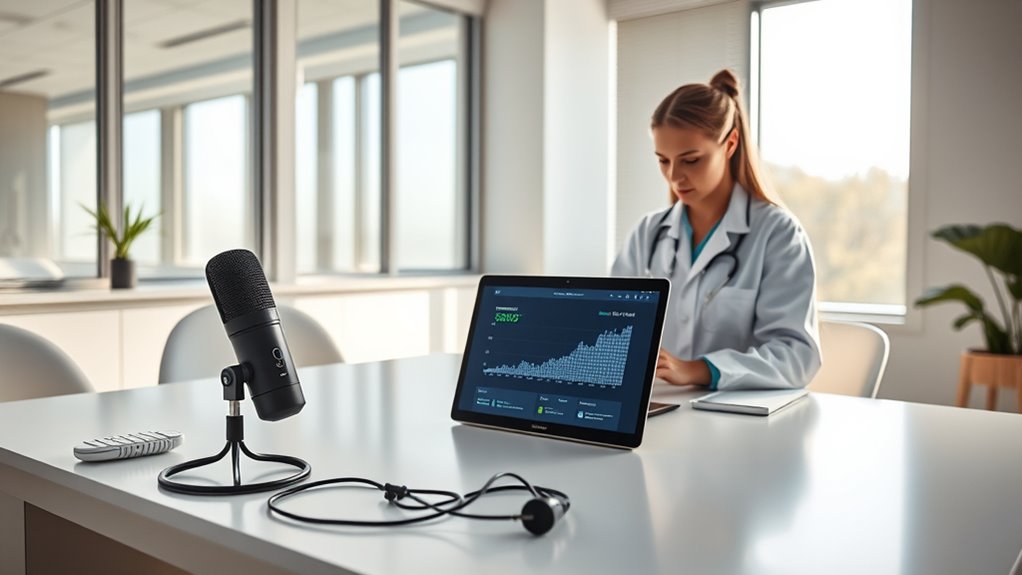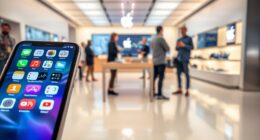Ambient listening technology transforms healthcare by automatically capturing and transcribing clinical conversations, reducing your documentation burden markedly. It streamlines workflow, freeing up more time for patient care and enhancing clinical efficiency. This tech helps ensure accurate, timely notes, while security measures protect sensitive data. Despite privacy concerns, proper implementation builds trust and compliance. If you want to discover how this innovation can improve your practice and patient outcomes, keep exploring the details below.
Key Takeaways
- Ambient listening devices automatically transcribe clinical interactions, reducing manual documentation tasks for healthcare providers.
- They enhance workflow efficiency by providing real-time, accurate clinical notes, allowing clinicians to focus more on patient care.
- Robust security measures ensure sensitive health data remains confidential, addressing privacy concerns associated with continuous recording.
- These technologies support compliance standards like HIPAA by enabling secure data handling and transparent patient communication.
- Implementing ambient listening tools streamlines documentation, improves clinical accuracy, and promotes a more patient-centered healthcare experience.

Ambient listening technology is transforming healthcare by automatically capturing and transcribing clinical interactions, allowing providers to focus more on patient care. With this innovation, the traditional burden of manual note-taking diminishes, giving clinicians more time to engage directly with their patients. However, as you adopt this technology, you need to be mindful of patient privacy concerns. Ensuring that sensitive health information remains secure is paramount, especially as ambient listening devices continuously record conversations. Healthcare providers must implement robust security measures, such as encryption and strict access controls, to prevent unauthorized data access. Transparency about how the technology works and what data is collected helps build trust with patients, easing their concerns about privacy.
Adopting ambient listening tech requires overcoming some barriers related to technology acceptance among staff. Many clinicians might worry about whether the system accurately captures complex medical conversations or if it might miss fundamental details. Training plays a key role here; you’ll need to familiarize your team with the device’s capabilities and limitations, emphasizing that this tool is meant to complement, not replace, clinical judgment. Demonstrating its accuracy and reliability can foster confidence and encourage widespread adoption. Additionally, integrating the technology seamlessly into existing workflows minimizes disruptions, making the changeover smoother for everyone involved.
As you implement ambient listening systems, you’ll also see that they can considerably reduce documentation time, freeing up your staff to focus on patient engagement and care quality. Automated transcription of clinical notes means less time spent on typing or dictating notes later, which often delays care or adds to clinician workload. This can lead to more timely, accurate documentation, ultimately improving patient outcomes. Still, it’s essential to establish clear protocols for reviewing and verifying transcribed notes to maintain accuracy and compliance with healthcare regulations like HIPAA. Utilizing vetted products ensures the technology meets safety and effectiveness standards.
In embracing ambient listening technology, you’re taking a step toward modernizing your practice. The key is balancing innovation with privacy and security, ensuring that patient trust remains intact. As more providers adopt this approach, you’ll find that it not only streamlines administrative tasks but also promotes a more patient-centered experience. When properly managed, ambient listening tech can be a powerful tool that enhances clinical efficiency, preserves patient privacy, and supports better healthcare delivery overall.
Frequently Asked Questions
How Secure Is Patient Data With Ambient Listening Technology?
Your patient data remains secure with ambient listening technology when it uses robust data encryption and strict privacy policies. These measures protect information from unauthorized access and guarantee compliance with healthcare regulations. You should verify that the technology provider follows industry standards and regularly updates security protocols. By doing so, you can confidently trust that patient confidentiality is maintained, and sensitive data stays protected throughout the process.
Can This Tech Detect Non-Verbal Patient Cues?
Think of ambient listening tech as a finely tuned antenna, picking up more than words. It can detect non-verbal cues and patient emotions by analyzing tone, facial expressions, and body language. This technology acts like a window into what patients might not say aloud, providing you with a fuller picture of their experience. With this, you can better understand and respond to their needs, even when words fall short.
What Training Is Required for Clinicians to Use This System?
You’ll need targeted user training to integrate this ambient listening tech into your clinical workflow effectively. The training covers system setup, real-time monitoring, and troubleshooting, ensuring you understand how to capture accurate notes and interpret non-verbal cues. This way, you streamline documentation, enhance patient interactions, and minimize disruptions. Proper training empowers you to maximize the system’s benefits, making your clinical workflow more efficient and responsive to patient needs.
How Does Ambient Listening Handle Multiple Patients Simultaneously?
Managing multiple patients becomes more manageable with ambient listening tech through sophisticated sound separation. You simply set the system to focus on distinct audio sources, enabling seamless multi-patient management. The technology isolates individual voices, reducing confusion and enhancing clarity. This active audio source separation supports your clinical workflow, making it easier to accurately document conversations and deliver attentive, crucial care without missing essential details in busy, multi-patient environments.
Is There Any Impact on Patient Privacy During Recordings?
Yes, patient privacy can be impacted during recordings if proper measures aren’t in place. You need patient consent before recording, ensuring they agree to the process. Additionally, data encryption is essential to protect sensitive information from unauthorized access. By following these protocols, you minimize privacy risks and maintain trust, ensuring recordings are secure and compliant with privacy regulations.
Conclusion
Imagine having a silent partner that listens and captures every word, turning chaos into clarity. Ambient listening tech acts as your unseen scribe, easing your burden and freeing you to focus on what truly matters—your patient. It’s like a gentle breeze that clears the fog of paperwork, revealing a clearer path forward. With this innovation, you’re not just saving time—you’re opening the door to more compassionate, attentive care. The future of medicine whispers promises of simplicity and connection.









